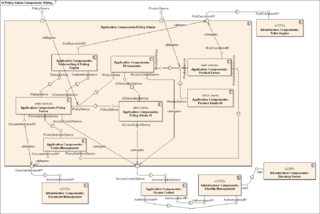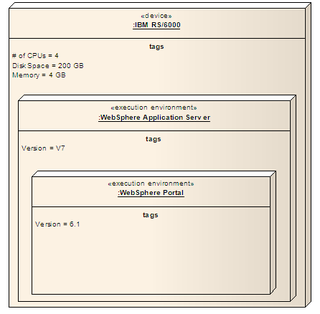This article needs additional citations for verification .(January 2014) (Learn how and when to remove this template message) |
In the Unified Modeling Language 1.x, powertype is a keyword for a specific UML stereotype, and applies to a class or dependency. Powertype shows a classifier whose instances (objects) are children of the given parent.

The Unified Modeling Language (UML) is a general-purpose, developmental, modeling language in the field of software engineering that is intended to provide a standard way to visualize the design of a system.
A stereotype is one of three types of extensibility mechanisms in the Unified Modeling Language (UML), the other two being tags and constraints. They allow designers to extend the vocabulary of UML in order to create new model elements, derived from existing ones, but that have specific properties that are suitable for a particular domain or otherwise specialized usage. The nomenclature is derived from the original meaning of stereotype, used in printing. For example, when modeling a network you might need to have symbols for representing routers and hubs. By using stereotyped nodes you can make these things appear as primitive building blocks.
In the Unified Modeling Language (UML), a Dependency is a relationship that shows that an element, or set of elements, requires other model elements for their specification or implementation. The element is dependent upon the independent element, called the supplier. Two or more elements in this relationship are called tuples.
In UML 2.x, a powertype is a metaclass whose instances are subclasses of a given class. The stereotype has been removed and the powertype is now indicated by typing the generalization set.
In object-oriented programming, a metaclass is a class whose instances are classes. Just as an ordinary class defines the behavior of certain objects, a metaclass defines the behavior of certain classes and their instances. Not all object-oriented programming languages support metaclasses. Among those that do, the extent to which metaclasses can override any given aspect of class behavior varies. Metaclasses can be implemented by having classes be first-class citizen, in which case a metaclass is simply an object that constructs classes. Each language has its own metaobject protocol, a set of rules that govern how objects, classes, and metaclasses interact.
In the UML Superstructure 2.4.1 Specification Document [1] the following definition is given:
The notion of power type was inspired by the notion of power set. A power set is defined as a set whose instances are subsets. In essence, then, a power type is a class whose instances are subclasses.








